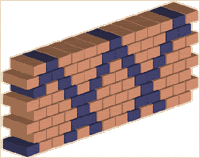| Frogged or perforated brickwork should always be covered over if left unfinished for any period when rain is likely, to prevent the frogs or perforations filling with water which would make a mess of the bed mortar when the bricklaying starts again. Pointing StylesPointing ensures the bed joints & perp ends are properly filled with mortar. Pointing is usually done an hour or so after the bricks have been laid,just long enough for the mortar to stiffen but not so long that it has become`s unworkable. The unpointed joints can be topped up with fresh mortar if they are not quite full, before tooling to the required style.The most common pointing styles are shown below. The Weatherstruck & Flush type`s are formed with the blade of a trowel. The Bucket Handle profile is formed with a semi-circular section jointing bar, the Recess type is created with a joint raker or chariot. Tooled joints offer better resistance to rain penetration.  Other topics Brick bonds Brick types Copings Retaining walls Pointing Mixing mortar  |
Kings Heath Builders Directory

